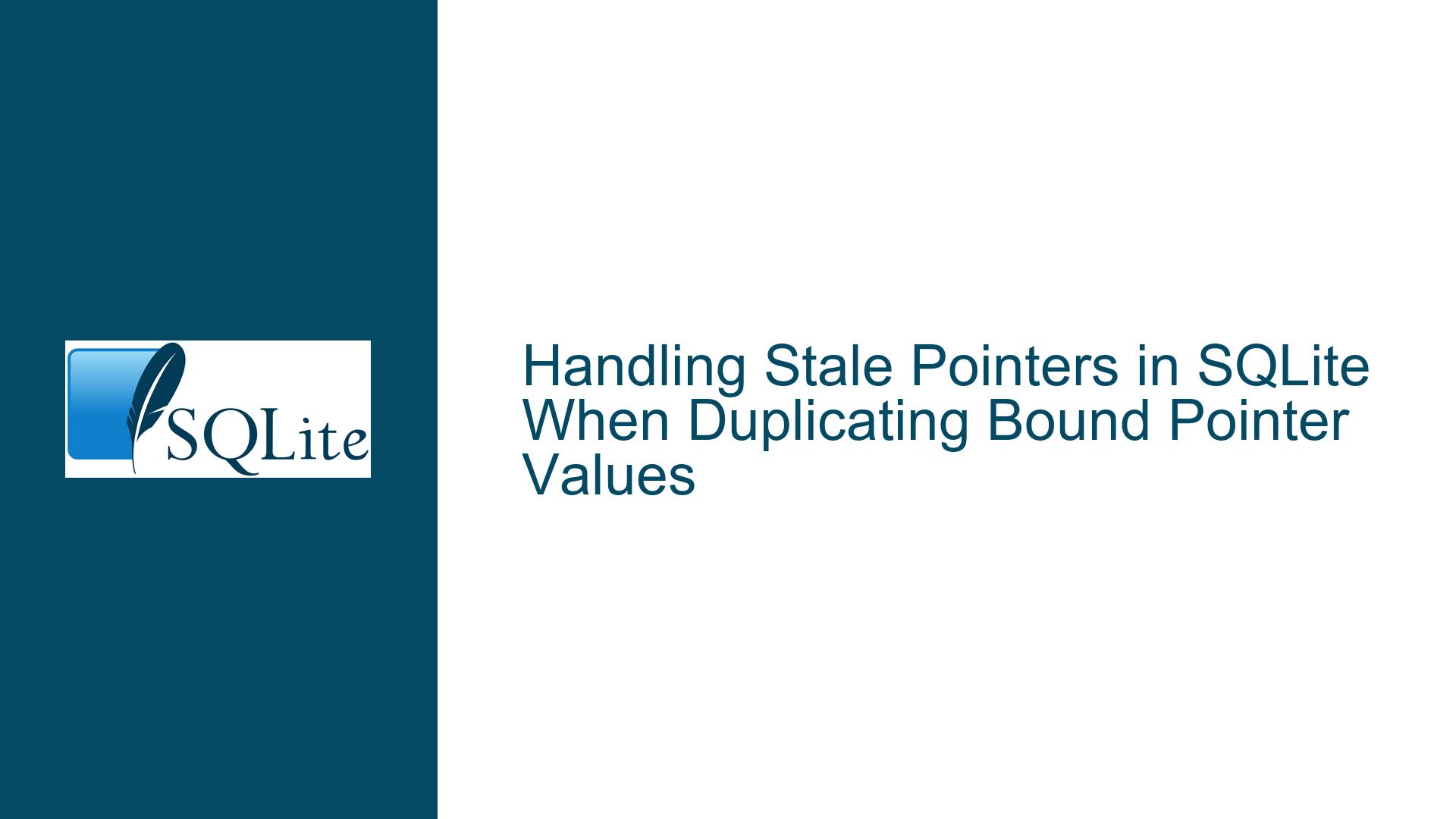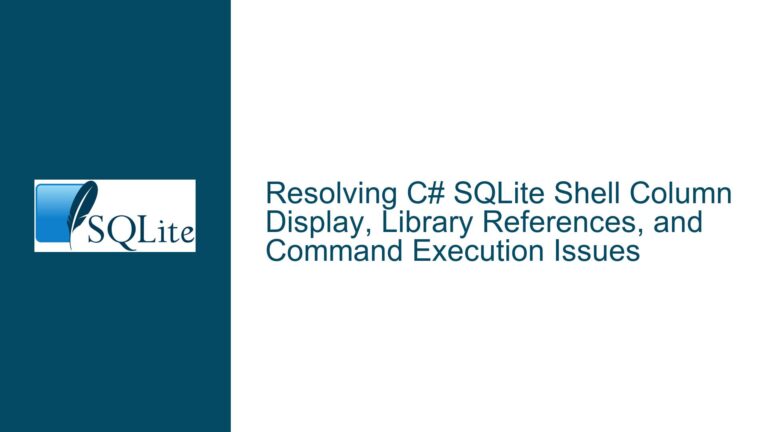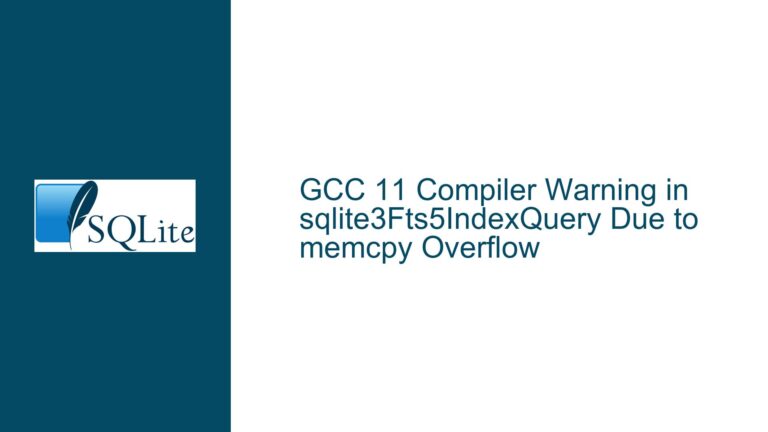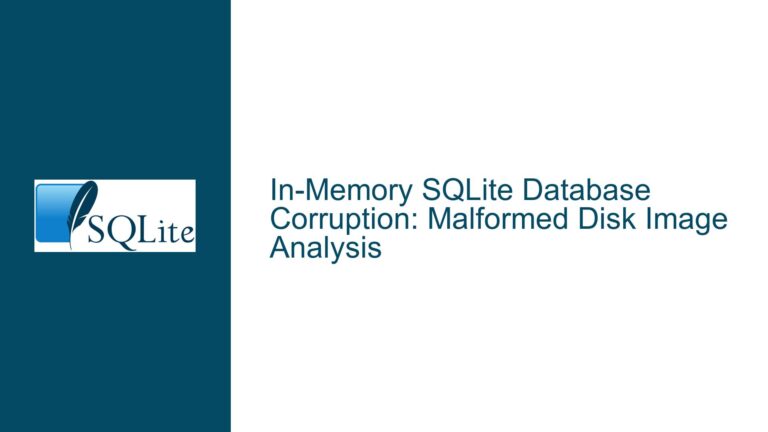Handling Stale Pointers in SQLite When Duplicating Bound Pointer Values
Issue Overview: Stale Pointers from sqlite3_value_dup on Pointer-Type Values
When working with SQLite’s C/C++ API, developers may encounter a critical issue involving stale pointers after using the sqlite3_value_dup() function on values derived from bound pointers. This problem manifests when a pointer bound to a prepared statement via sqlite3_bind_pointer() is duplicated using sqlite3_value_dup(), resulting in a cloned sqlite3_value object that retains a reference to the original pointer even after the original pointer has been destroyed. The destruction of the original pointer is typically triggered by the finalization of the prepared statement or the closure of the database connection, which invokes the registered destructor callback for the bound pointer.
In the provided example, the cloned sqlite3_value object continues to report the original pointer address via sqlite3_value_pointer() even after the destructor has been called, leading to a dangling pointer. This creates undefined behavior risks, including memory corruption, segmentation faults, or data integrity issues if the stale pointer is dereferenced or reused. The core issue lies in SQLite’s handling of pointer-type values during duplication and its lack of lifecycle coordination between the original and cloned values.
The problem is exacerbated by SQLite’s design philosophy of minimal overhead for pointer values: bound pointers are treated as opaque references without built-in reference counting or deep-copy mechanisms. When sqlite3_value_dup() is called on a pointer-type value, SQLite merely copies the pointer address into the new sqlite3_value object without associating it with the original destructor or tracking its lifetime. This creates a situation where the cloned value outlives the original pointer’s validity, violating the developer’s expectations of memory safety.
Possible Causes: Lifecycle Mismatches and Missing Indirection for Duplicated Pointer Values
1. Lack of Reference Counting for Bound Pointer Values
SQLite’s API for binding pointers (sqlite3_bind_pointer()) allows developers to associate a destructor function with the pointer. However, this destructor is invoked exactly once—when the prepared statement is finalized or the value is explicitly cleared. When a pointer is duplicated via sqlite3_value_dup(), SQLite does not create a new reference to the underlying data or associate the cloned value with the original destructor. The cloned value becomes a standalone copy of the pointer address, completely decoupled from the lifecycle management of the original pointer. This design choice prioritizes performance but introduces risks when cloned values outlive their source.
2. Shallow Copy Semantics of sqlite3_value_dup()
The sqlite3_value_dup() function is designed to create a deep copy of certain data types (e.g., strings, blobs) but performs a shallow copy for pointer-type values. For strings and blobs, SQLite internally manages reference counts or copies the buffer to ensure the duplicated value remains valid independently. For pointers, however, no such mechanism exists. The function simply copies the pointer address into the new sqlite3_value object without regard for the pointer’s ownership or lifetime. This results in cloned values that reference memory that may have been freed or reused.
3. Destructor Invocation Timing and Scope
The destructor registered via sqlite3_bind_pointer() is tied to the lifecycle of the bound value within the prepared statement. When the statement is finalized, the destructor is called, invalidating the pointer. However, any cloned values created from the bound pointer during the statement’s execution exist outside this lifecycle boundary. Since the cloned values are independent sqlite3_value objects, their destruction (via sqlite3_value_free()) does not trigger the original destructor, nor do they inherit any form of lifecycle linkage to the original pointer. This creates a "use-after-free" scenario where the cloned value’s pointer becomes stale immediately after the statement is finalized.
4. Ambiguity in Pointer Ownership
SQLite’s API does not enforce a clear ownership model for duplicated pointer values. While the original bound pointer is owned and managed by the prepared statement, the cloned pointer exists in a limbo state: it is not owned by any SQLite-managed construct (e.g., a statement, connection, or value list). Developers might incorrectly assume that sqlite3_value_dup() transfers or shares ownership of the pointer, leading to mismanagement of resources. The absence of a standardized ownership protocol for duplicated pointers exacerbates the risk of lifecycle mismatches.
Troubleshooting Steps, Solutions & Fixes: Mitigating Stale Pointers in Duplicated Values
1. Immediate Workaround: Avoid Duplicating Pointer Values
The simplest mitigation is to avoid using sqlite3_value_dup() on pointer-type values altogether. If the use case requires preserving a pointer beyond the lifetime of the original prepared statement, developers should instead:
- Extract the pointer immediately and manage its lifecycle externally.
- Use application-level reference counting to track usage.
- Replace pointer duplication with serialization (e.g., converting the pointer to an integer or string handle).
Example:
// Extract the pointer and manage it externally
sqlite3_value* orig = sqlite3_column_value(stmt, 0);
void* ptr = sqlite3_value_pointer(orig, "example");
// Increment application-managed reference count
my_refcount_increment(ptr);
2. Adopt SQLite’s Trunk Fix: Nullify Duplicated Pointers
As confirmed in the discussion, SQLite’s trunk version now returns a NULL value when sqlite3_value_dup() is called on a pointer-type value. Developers can:
- Upgrade to a SQLite version containing the fix (3.37.1 or newer).
- Check for NULL after duplication and handle accordingly.
Code adjustment:
sqlite3_value* cloned = sqlite3_value_dup(orig);
if (cloned == NULL) {
// Handle missing duplicated value
}
3. Implement Custom Reference-Counted Pointer Wrappers
For scenarios requiring pointer duplication, developers can introduce a layer of indirection with reference counting:
- Define a wrapper structure containing the pointer and a reference count.
- Use a custom destructor that decrements the count and frees memory when the count reaches zero.
Example:
typedef struct {
void* ptr;
int refcount;
} RefCountedPtr;
static void refcounted_destructor(void* data) {
RefCountedPtr* rc_ptr = (RefCountedPtr*)data;
rc_ptr->refcount--;
if (rc_ptr->refcount == 0) {
free(rc_ptr->ptr);
free(rc_ptr);
}
}
// Binding the pointer with reference counting
RefCountedPtr* rc_ptr = malloc(sizeof(RefCountedPtr));
rc_ptr->ptr = my_data;
rc_ptr->refcount = 1;
sqlite3_bind_pointer(stmt, 1, rc_ptr, "refcounted", refcounted_destructor);
// Duplicating the value (increment refcount)
sqlite3_value* orig = sqlite3_column_value(stmt, 0);
RefCountedPtr* cloned_rc = malloc(sizeof(RefCountedPtr));
memcpy(cloned_rc, sqlite3_value_pointer(orig, "refcounted"), sizeof(RefCountedPtr));
cloned_rc->refcount++;
sqlite3_value* cloned = sqlite3_value_pointer(cloned_rc, "refcounted");
4. Leverage SQLite’s Built-in Resource Management for Blobs and Strings
If the pointer references data that can be represented as a blob or string, use SQLite’s native duplication mechanisms:
- Convert pointers to strings or integers for safe duplication.
- Store data in blobs with
SQLITE_TRANSIENTto let SQLite manage copies.
Example:
// Convert pointer to string
char ptr_str[20];
sprintf(ptr_str, "%p", my_ptr);
sqlite3_bind_text(stmt, 1, ptr_str, -1, SQLITE_TRANSIENT);
// Retrieve and convert back
const char* cloned_str = sqlite3_value_text(cloned);
void* cloned_ptr = NULL;
sscanf(cloned_str, "%p", &cloned_ptr);
5. Audit Code for sqlite3_value_dup() Usage on Pointers
Conduct a systematic review of all sqlite3_value_dup() calls to ensure they are not applied to pointer-type values. Use static analysis tools or runtime checks to detect misuse:
// Runtime type check before duplication
if (sqlite3_value_type(orig) == SQLITE_POINTER) {
// Avoid duplication or handle specially
}
6. Modify SQLite Build with Custom Pointer Handling
For mission-critical applications requiring pointer duplication, consider patching SQLite to include reference counting for pointers:
- Extend the
sqlite3_valuestructure to include reference counts for pointers. - Modify
sqlite3_value_dup()to increment counts and bind destructors.
Patch outline:
// In sqlite3Int.h
struct sqlite3_value {
union {
// ... existing fields ...
struct {
void* ptr;
void (*destructor)(void*);
int refcount;
} ptr_val;
} u;
};
// In sqlite3ValueDup()
case SQLITE_POINTER:
if (pFrom->u.ptr_val.refcount > 0) {
pTo->u.ptr_val = pFrom->u.ptr_val;
pTo->u.ptr_val.refcount++;
}
break;
7. Adopt Delayed Pointer Destruction with Statement Associations
Associate pointers with the database connection instead of the prepared statement, delaying destruction until connection closure. This requires:
- Global pointer registry tied to the connection.
- Custom destructor invocation during
sqlite3_close().
Example:
typedef struct {
void* ptr;
void (*destructor)(void*);
} ConnPtr;
// Register pointer with connection
ConnPtr* conn_ptr = sqlite3_malloc(sizeof(ConnPtr));
conn_ptr->ptr = my_ptr;
conn_ptr->destructor = my_destructor;
sqlite3_bind_pointer(stmt, 1, conn_ptr, "conn_ptr", conn_ptr_destructor);
// Destructor invoked at connection close
static void conn_ptr_destructor(void* data) {
ConnPtr* conn_ptr = (ConnPtr*)data;
conn_ptr->destructor(conn_ptr->ptr);
sqlite3_free(conn_ptr);
}
8. Document and Enforce Pointer Lifecycle Policies
Establish clear guidelines for pointer management in SQLite interactions:
- Prohibit long-lived clones of pointer values.
- Mandate immediate extraction of pointers from
sqlite3_valueobjects. - Centralize pointer ownership in application-layer structures.
9. Use SQLite’s User Data Registration for Global Resources
For pointers referencing global or long-lived resources, register them with SQLite’s user data system to avoid premature destruction:
// Register global data
sqlite3* db;
sqlite3_open(":memory:", &db);
void* global_data = malloc(100);
sqlite3_set_authorizer(db, global_data, my_auth_callback);
// Retrieve in callbacks
void* global_data = sqlite3_get_authorizer_data(db);
10. Transition to Alternative Data Passing Mechanisms
Replace pointer binding with alternative methods better suited for duplication:
- Row-based identifiers for in-memory objects.
- Temporary tables storing serialized data.
- User-defined functions encapsulating pointer logic.
Example using temporary tables:
// Create temp table with data
sqlite3_exec(db, "CREATE TEMP TABLE temp_data (id INTEGER PRIMARY KEY, data BLOB)", 0, 0, 0);
sqlite3_stmt* insert_stmt;
sqlite3_prepare_v2(db, "INSERT INTO temp_data (data) VALUES (?)", -1, &insert_stmt, 0);
sqlite3_bind_blob(insert_stmt, 1, my_data, data_size, SQLITE_TRANSIENT);
sqlite3_step(insert_stmt);
int64_t rowid = sqlite3_last_insert_rowid(db);
// Retrieve data via rowid
sqlite3_stmt* select_stmt;
sqlite3_prepare_v2(db, "SELECT data FROM temp_data WHERE id = ?", -1, &select_stmt, 0);
sqlite3_bind_int64(select_stmt, 1, rowid);
sqlite3_step(select_stmt);
const void* data = sqlite3_column_blob(select_stmt, 0);
By systematically applying these solutions, developers can eliminate stale pointer risks while maintaining SQLite’s performance benefits. The optimal approach depends on the specific use case, ranging from simple API adjustments to architectural redesigns of data management.






